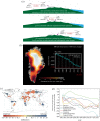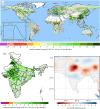Earth's water reservoirs in a changing climate
- PMID: 32398926
- PMCID: PMC7209137
- DOI: 10.1098/rspa.2019.0458
Earth's water reservoirs in a changing climate
Abstract
Progress towards achieving a quantitative understanding of the exchanges of water between Earth's main water reservoirs is reviewed with emphasis on advances accrued from the latest advances in Earth Observation from space. These exchanges of water between the reservoirs are a result of processes that are at the core of important physical Earth-system feedbacks, which fundamentally control the response of Earth's climate to the greenhouse gas forcing it is now experiencing, and are therefore vital to understanding the future evolution of Earth's climate. The changing nature of global mean sea level (GMSL) is the context for discussion of these exchanges. Different sources of satellite observations that are used to quantify ice mass loss and water storage over continents, how water can be tracked to its source using water isotope information and how the waters in different reservoirs influence the fluxes of water between reservoirs are described. The profound influence of Earth's hydrological cycle, including human influences on it, on the rate of GMSL rise is emphasized. The many intricate ways water cycle processes influence water exchanges between reservoirs and thus sea-level rise, including disproportionate influences by the tiniest water reservoirs, are emphasized.
Keywords: earth observations; reservoirs; water.
© 2020 The Author(s).
Conflict of interest statement
We declare we have no competing interests.
Figures
















References
-
- O'Brien DP, Izidoro A, Jacobson SA, Raymond SN, Rubie DC. 2018. The delivery of water during terrestrial planet formation. Space Sci. Rev. 214, 47 (10.1007/s11214-018-0475-8) - DOI
-
- Church JA, et al. 2013. Sea level change. In Climate change 2013: the physical science basis. Contribution of working group I to the fifth assessment report of the intergovernmental panel on climate change (eds Stocker TF, et al.). Cambridge, UK and New York, NY: Cambridge University Press.
-
- Leuliette EW, Nerem RS. 2016. Contributions of Greenland and Antarctica to global and regional sea level change. Oceanography 29, 154–159. (10.5670/oceanog.2016.107) - DOI
-
- Nerem RS, Chambers D, Choe C, Mitchum G. 2010. Estimating mean sea level change from TOPEX and Jason Altimeter Missions. Mar. Geod. 33(Suppl 1), 435–436. (10.1080/01490419.2010.491031) - DOI

